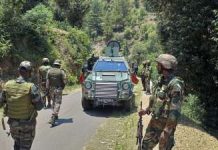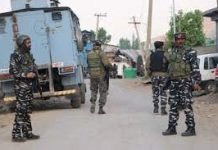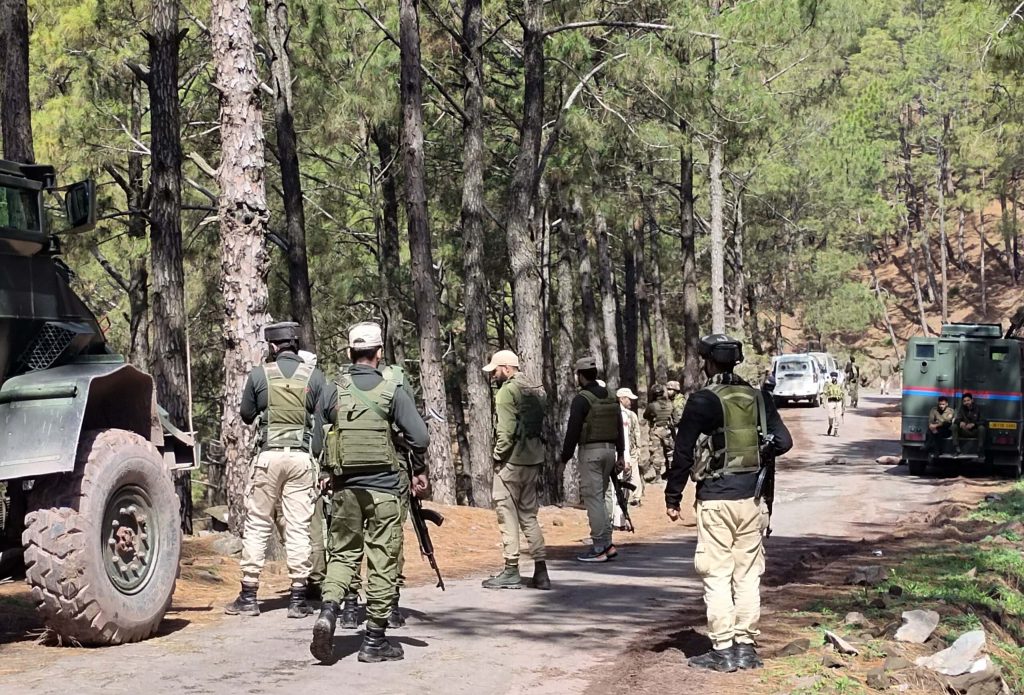
The UT sees a steep rise in violence with Jammu division turning into new hotbed of militancy as insurgents retreat into dense forests posing a new challenge to security forces, writes Riyaz Wani
The Pir Panjal forest in Jammu and Kashmir has become a new headache for security forces due to a string of encounters in recent years. Making use of the dense cover of the forests, militants strategically conceal their positions, capitalizing on the intricate terrain that includes treacherous mountains and dense jungles. In the latest encounter on November 22, two Army captains and three soldiers were killed in action in Kalakote forests of Rajouri district in Jammu division. Two militants were also killed which makes it different from the earlier encounters when they had escaped unscathed.
This year alone, around 30 security personnel have lost their lives in a series of gunfights, some of which were initiated by militants themselves. The first such encounter took place on April 20 at Bhata Dhurian area in Rajouri, where militants ambushed a security vehicle. They were reported to have fired piercing bullets at the vehicle from all sides and later blown it up with an IED. Subsequently, when the Army launched an operation to flush the militants out from their hideouts in the surrounding forests on May 5, they used an IED to halt the advance of approaching security personnel, in which five more soldiers lost their lives. The militant outfit, People’s Anti Fascist Front, later released a video accepting the responsibility.
Ever since, several more encounters – some of them also in Kashmir Valley – have taken place claiming more lives of personnel of security forces. In September, a seven-day long encounter in the forests surrounding Gadool village in South Kashmir’s Kokernag area resulted in the death of five personnel, including Col Manpreet Singh and Maj Ashish Dhonchak from the 19 Rashtriya Rifles, and DySP Humayun Bhat of J&K Police. Major Dhonchak was a recipient of the Sena Medal in 2023. The Resistance Front (TRF), a shadow group reportedly backed by Pakistan’s Lashkar-e-Taiba, was believed to be behind this attack.
The attacks have occurred intermittently, disrupting the uneasy calm that has prevailed in the union territory over the past four years. Though the Kashmir Valley has witnessed scores of encounters in recent years, a predominant majority of them have led to the killings of militants rather than those of security personnel. Ever since the withdrawal of J&K autonomy in August 2019, over 500 militants have been killed in the UT, most of them local youth. This has thinned out the presence of militants, and also reduced the violence. According to an estimate by Jammu and Kashmir Police, there are now only 40 local combatants among 111 active militants. This marks a significant decrease from the 137 active militants recorded the previous year. This is the first time since 2015 that the ratio between foreign and local militants has altered in favour of the former, reflecting a drastic dip in the local recruitment, which earlier replenished the depleted militant ranks due to the killings. However, with the influx of foreign militants, it appears that efforts are being made to compensate for the setback to local militancy.
But drying up of the local militancy represents a profound shift in the existing situation for the security agencies, prompting former DGP Dilbagh Singh, who retired recently, to conclude that militancy has all but finished in the valley now.
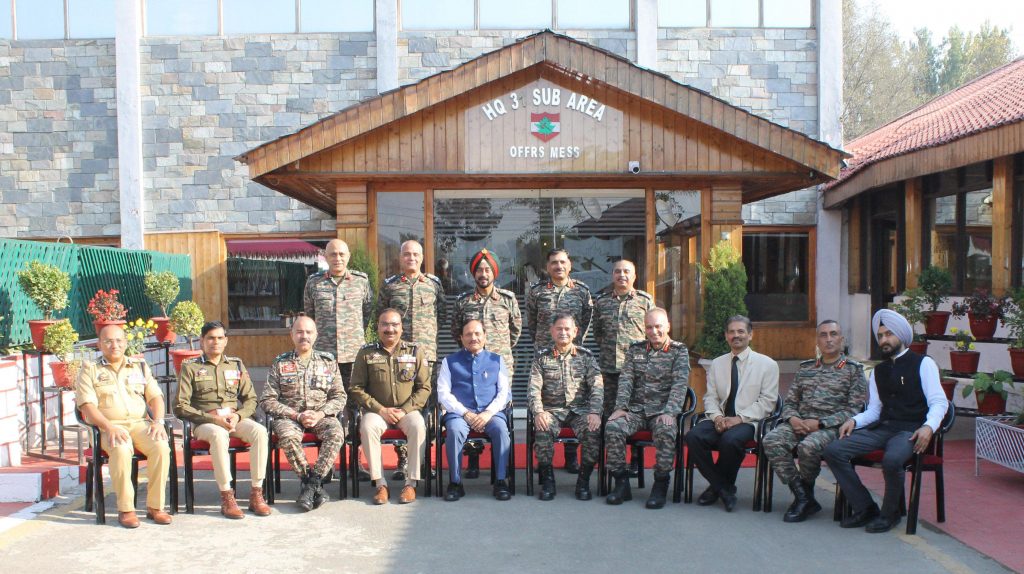
“This year, only 10 (local) youths have joined militancy. Last year, 110 had become militants. How good it would have been if none had joined the ranks because even among the 10, six have been killed, and the remaining four will also get killed,” Singh said shortly before his retirement on October 31.
On the other hand, the official figures suggested that around 160 locals had joined militancy in 2020 and 125 in 2021.
On the back foot because of their depleting numbers, local militants have in recent years chosen to attack soft targets – civilians, panchayat workers, J&K police personnel visiting home, outsiders and minorities – instead of engaging security personnel. Security forces, as a result, now not only have to combat militancy but also protect a large section of the population including many from among their own ranks.
But as things stand, the militancy seems to be evolving to regain its loosening grip.
Militants shift tack
Earlier, encounters between security forces and militants in Jammu and Kashmir rarely occurred in hilly terrain, except when they happened along the Line of Control. Does this show that the militants are withdrawing from the residential areas into the forests? Indeed, it does.
In recent years, security forces have achieved complete area domination and intelligence penetration in the urban areas and the countryside, making it increasingly fraught for militants to take shelter in residential areas. While this strategy has brought about peace in the otherwise volatile countryside in South Kashmir, militants have shifted to forests, making it more difficult for security forces to track them down
This is also apparent from the militancy-related violence in the union territory this summer, most of which has been concentrated in the hilly terrain stretching from Poonch and Rajouri in Jammu division up to the districts in South Kashmir.
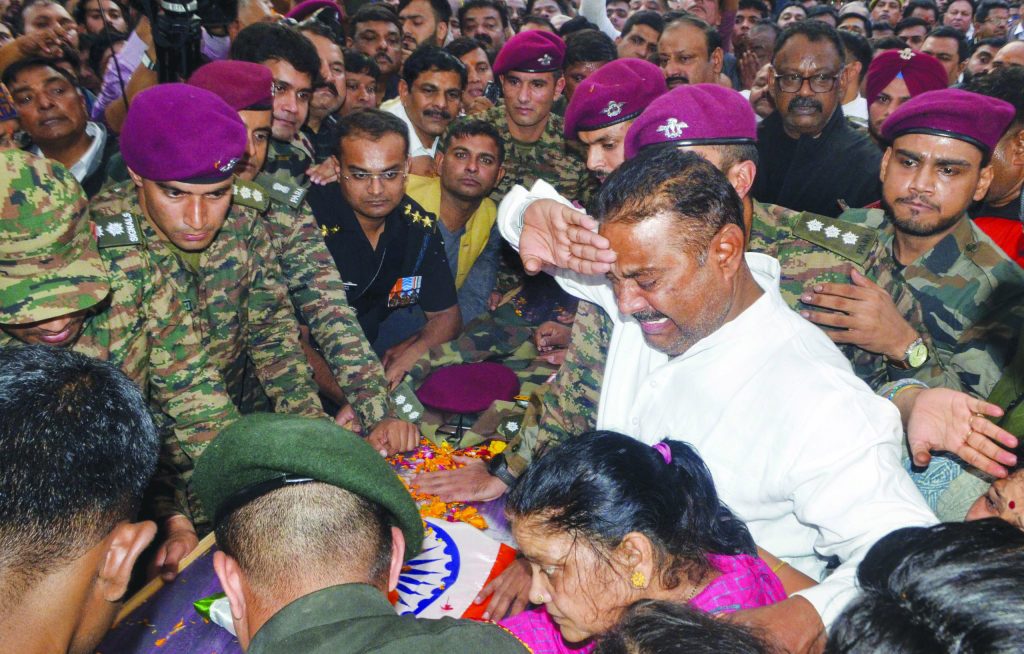
The hill warfare has confronted security forces with new formidable challenges. More so, in a largely hilly and mountainous terrain of Kashmir. The militants operating out of forests are difficult to locate and once located, difficult to be engaged in an encounter as has been clear in the successive gunfights this year. Most of the militancy related violence in which security personnel have been killed has taken place inside or close to forests.
The new development has shattered the notion that militancy in the region was on the wane, proving the age-old belief that no matter how many militants you kill in Kashmir, the militancy may not necessarily go away. The reason is that it requires a small group of militants to mount a sensational attack and disrupt the prevailing sense of calm.
Militancy makes a comeback
At a time when the militancy in Kashmir Valley has been at a low ebb, it is once again rearing its head in Jammu division, where it had been non-existent for almost two decades. Since 2021, Jammu has witnessed a steep spike in violence, leading to the killing of dozens of soldiers by the militants. And the fact that the militants who carry out these killings are mostly at large and their number remains unknown makes the future uncertain. It is likely that more violence is in store until the security forces track the militants down. So far, the extensive search in the jungles has yielded no result, but it may in the near future. Instead, contacts with militants have led to more casualties for security forces.
The situation has been made even more concerning by the fact that the forest area where the militants are hiding extends to Shopian in South Kashmir, the district that has been a hotbed of militancy in recent years. But the militants have chosen to largely stay in Jammu only, possibly because the region has a lower concentration of security forces than the Valley and also a warmer climate throughout the year.
The rise in militant activity in Jammu areas is linked to the thinning of the presence of security forces in the region in the last two years, a fact being exploited by the militants. Two reasons are offered for this state of affairs: one, the ceasefire along the Line of Control between India and Pakistan, which was renewed in early 2021, and has since held despite predictions to the contrary. Second the consequent redeployment of the Rashtriya Rifles, the main counter-insurgency force in Jammu and Kashmir, to the Line of Actual Control in Ladakh following China’s incursions along the border. This is believed to have created a void along the border in Jammu, which may have been taken advantage of by militants, resulting in a resurgence of violence in Jammu.
The militants who have infiltrated from across the border are believed to be very well-trained. It was obvious from the Kalakote encounter. One of the slain militants was identified as Qari, a Pakistani national, tasked with reviving terrorism in the region, a Jammu-based Defence spokesman told media at the time.
“He has been trained on the Pakistan and Afghan Front. He is a highly ranked terrorist leader of Lashkar-e-Taiba,” said the spokesman. “He has been active in Rajouri-Poonch along with his group for the past one year. He is also believed to be the mastermind of Dangri and Kandi attacks.”
In the Dangri twin terror attack, which occurred on January 1 and 2, 2023, at the Dangri village of Rajouri district, a shooting incident had resulted in the death of four and injuries to nine others. In the second attack, an IED exploded near the same attack site, resulting in the death of a child at the scene and injury to five others. A second child injured in that blast died from injuries, raising the overall death toll to six.
The rising militant activity in the Jammu division has become a huge source of concern for the security forces.
The government is now working on a plan to replicate the counterinsurgency strategy adopted in Kashmir Valley, to curb the rising violence in Jammu. This includes identification and arrest of over-ground supporters of militants, proactive counter-insurgency operations, deployment of police, Army, Central Armed Police Force (CAPF) and night patrolling and area domination, which are believed to have helped check infiltration to a large extent in the Kashmir region.
“In Kashmir, we adopted a 360-degree approach to maintain peace. My government succeeded to a large extent,” said Lieutenant Governor Manoj Sinha in a recent statement “Jammu was peaceful earlier, but Rajouri and Poonch districts have witnessed some unfortunate incidents in the recent past. However, the plans adopted by security and intelligence agencies to finish terrorism in the Kashmir Valley are now being implemented in the twin border districts of Rajouri and Poonch to ensure that peace returns in these regions as well.”
Local and foreign militants
It is not clear whether the local and foreign militants coordinate their attacks or cross paths. But it is obvious they generally don’t. While local militants continue to live in residential areas, where they usually get easily tracked down and killed in brief gunfights, foreigners now mostly inhabit forests. Locals are poorly armed and trained whereas the foreigners are battle-hardened. However, the foreign militant-related violence has so far remained confined to forests, so it hasn’t affected the general drift of normalcy prevailing in Kashmir in the last four years.
For security agencies, the main worry has been the local recruitment into militancy, which has waxed and waned, but has never stopped altogether. All efforts so far to bring local recruitment to zero have not succeeded. But this year has been different, with a least number of local youth joining the militancy. The coming weeks and months will be crucial as to how things will evolve on this score. An end to local recruitment could render foreign militants ineffective, as local militants and overground workers act as eyes and ears of their foreign counterparts.
Gaza factor
On October 25, a high-level security review meeting was convened in Srinagar in the backdrop of the ongoing Middle East crisis to discuss its potential impact on Jammu and Kashmir.
The meeting took place at the headquarters of the 15 Corps in Srinagar and was chaired by R R Bhatnagar, Advisor to J&K, and Lieutenant General Upendra Dwivedi, Army Commander, Northern Command, along with other top intelligence officers.
Its primary objective was to coordinate and strategize security measures in response to the Israel-Palestine conflict. Various senior officials from the military, administration, and security agencies, including DGP, J&K police, Dilbag Singh and the Chinar Corps Commander, were in attendance.
During the discussions, numerous aspects related to the prevailing security situation in the Union Territory were addressed. The ongoing situation in the Middle East was deliberated upon, and contingency scenarios were discussed to ensure preparedness for any potential development.
Over a month since the outbreak of Israel-Hamas hostilities, Kashmir has remained calm. But it is also true that the anger and resentment has remained largely subterranean.
But the question is whether October 7 Hamas attacks followed by Israeli invasion would have an impact in Kashmir? Many would say that the disproportionate Israeli response and so far futility of the Hamas action in terms of furthering the Palestinian cause might act as a dampener for Kashmiri separatists. But as the high-level security review underlines, there are genuine fears that the Gaza situation may stir things up in Kashmir sooner or later.
It is apprehended that Kashmiri militants may have been watching the progress of war right from the Hamas attack on October 7 and may be interested in seeing what its outcome would be. The October 7 attack suddenly made Israel’s vaunted deterrence look vulnerable, and it has since been trying hard to reinstate its disproportionate military superiority over Hamas. But it is not clear whether Israel has dented the combative power of Hamas whose members are believed to be holed up in a network of underground tunnels. This will only be clear when the war ends.
However, look closely and it becomes clear that there can be no plausible comparison between what is happening in Palestine and that in Kashmir. These are different issues. Militancy in Kashmir has now reduced drastically. In fact, it is barely managing to keep itself afloat. Hamas, on the other hand, is said to have a 40,000-strong military wing, a military academy training, a range of specialisations including cyber security, and a naval commando unit. It has also put together a military infrastructure in the form of hundreds of miles of underground tunnels. This has enabled the group to mount a veritable invasion of Israel through land, water and air. And the mighty nuclear-armed military of Israel has been struggling to eliminate Hamas.
That said, the conflicts do feed off each other. The tactics adopted by militants in one part of the world are adopted in the other. This is what makes the October 7 attack on Israel a source of worry for the governments around the world. This could embolden militant groups operating in different parts of the world to stage copycat attacks, creating a dire need for the countries dealing with local conflicts to reorient their military and even political responses.
“Over the past nine years, more so, over the past four years, New Delhi has adopted an iron-fist security centric approach to deal with Kashmir,” said a Kashmiri politician who didn’t want to be identified. “It is about time that the union government extends a political outreach to the Valley and to begin with, it needs to restore statehood forthwith.”

